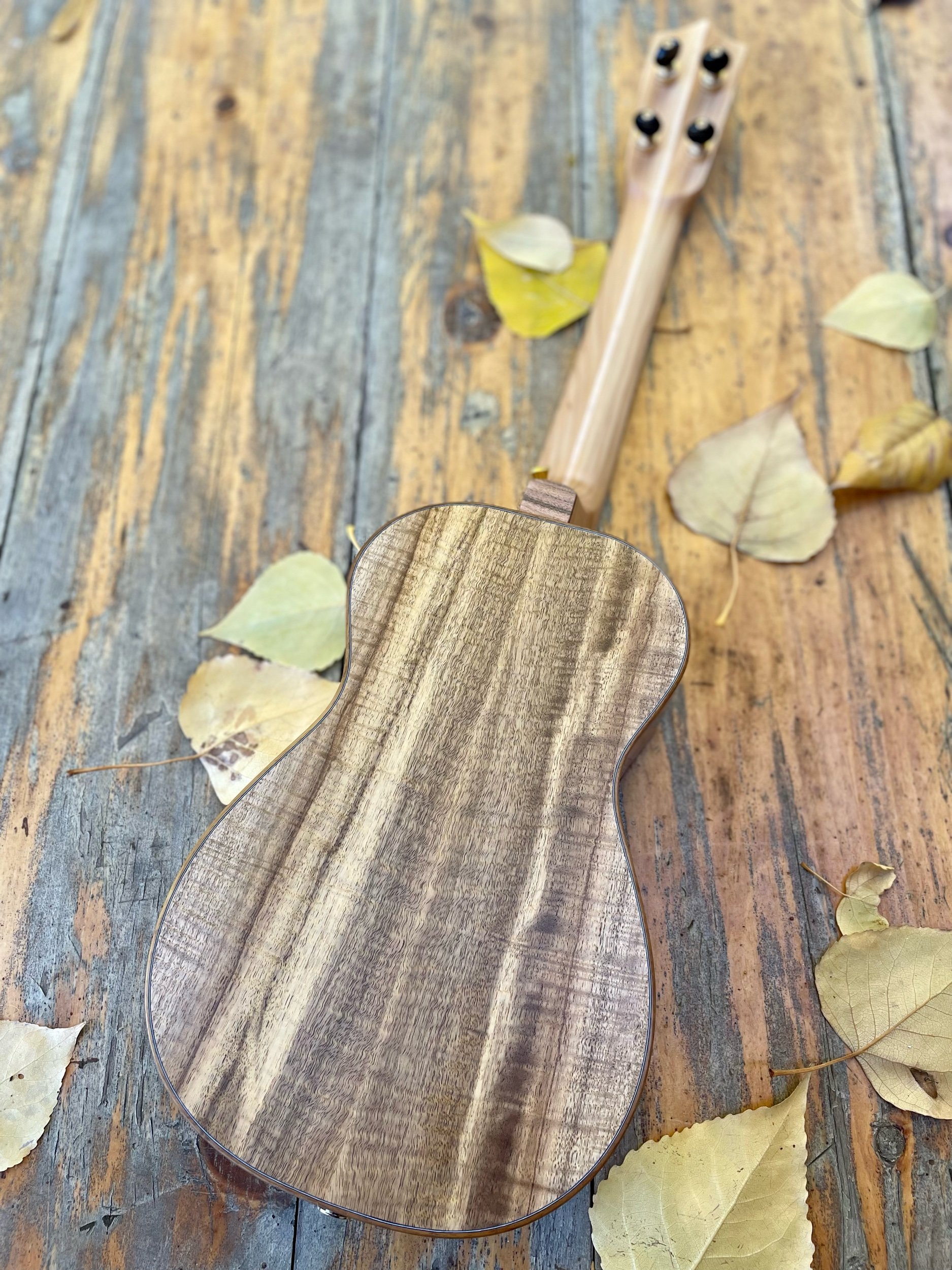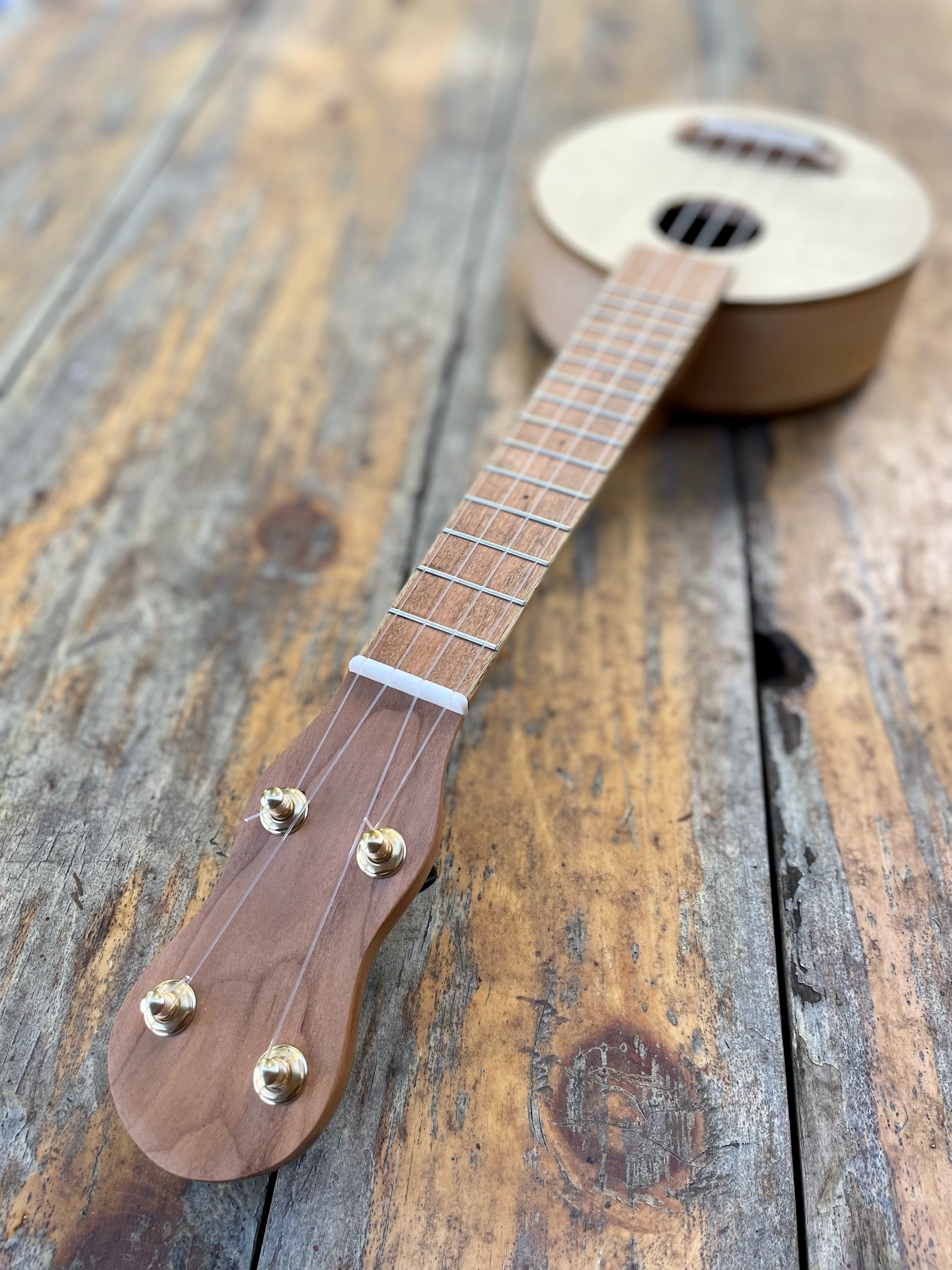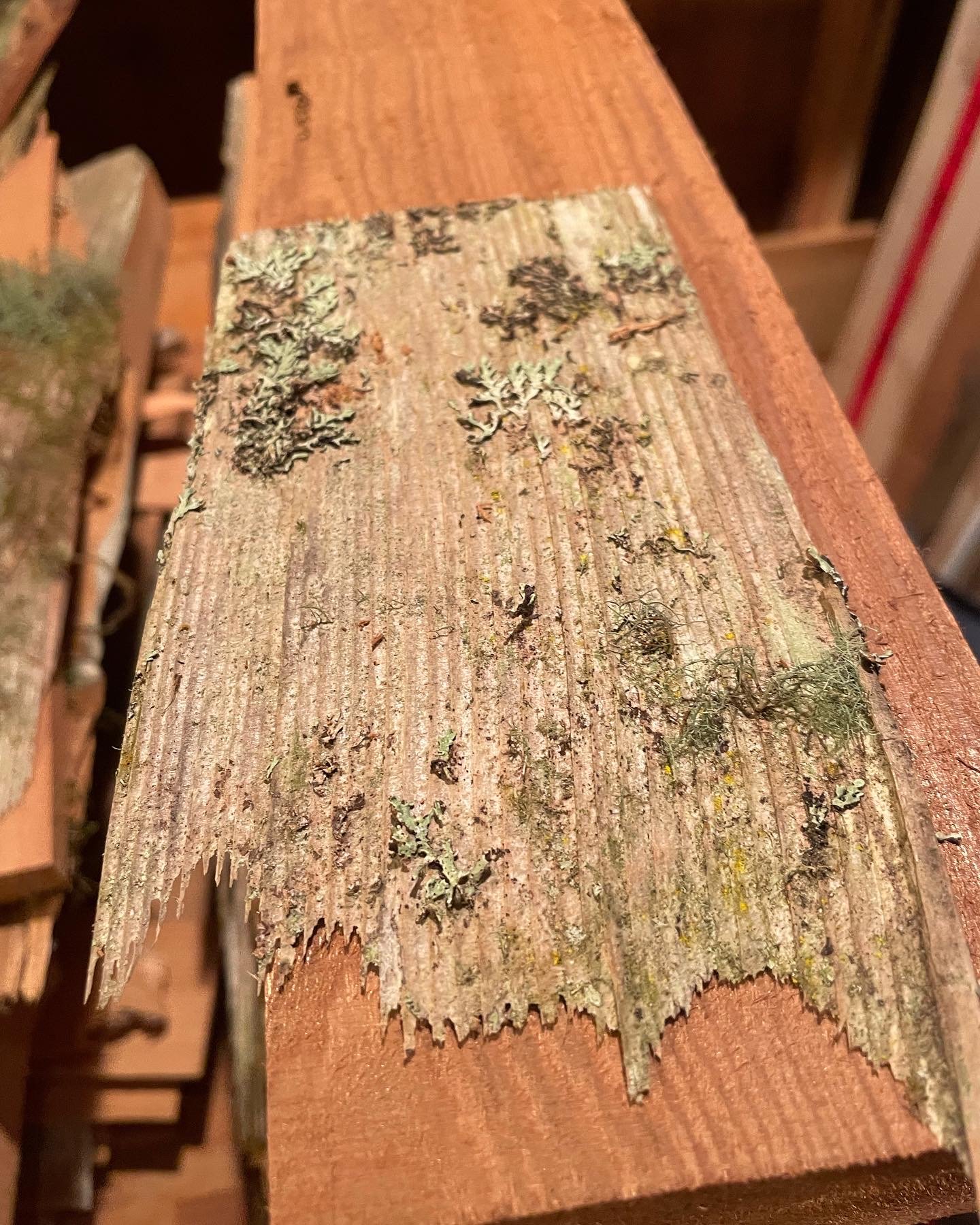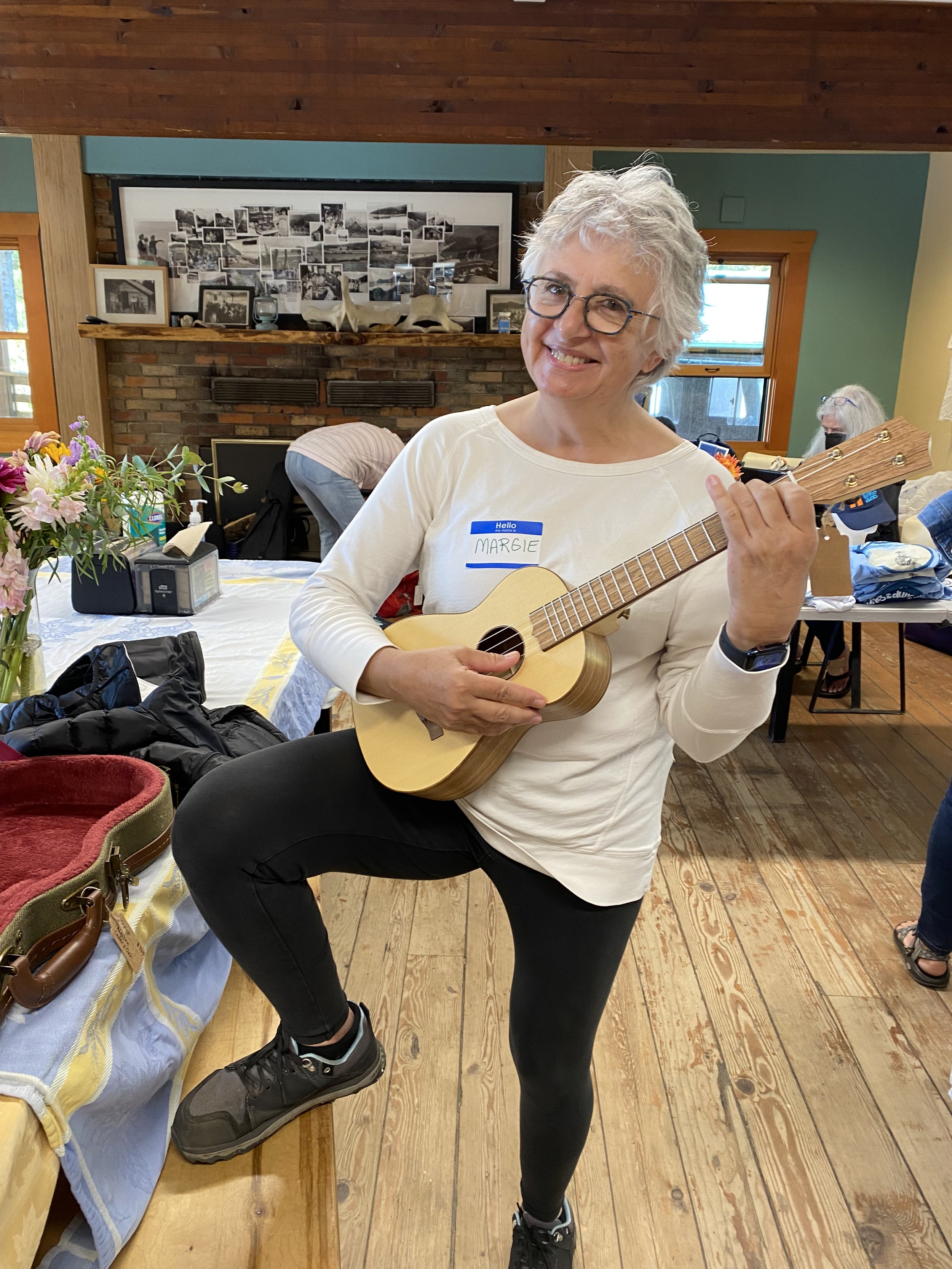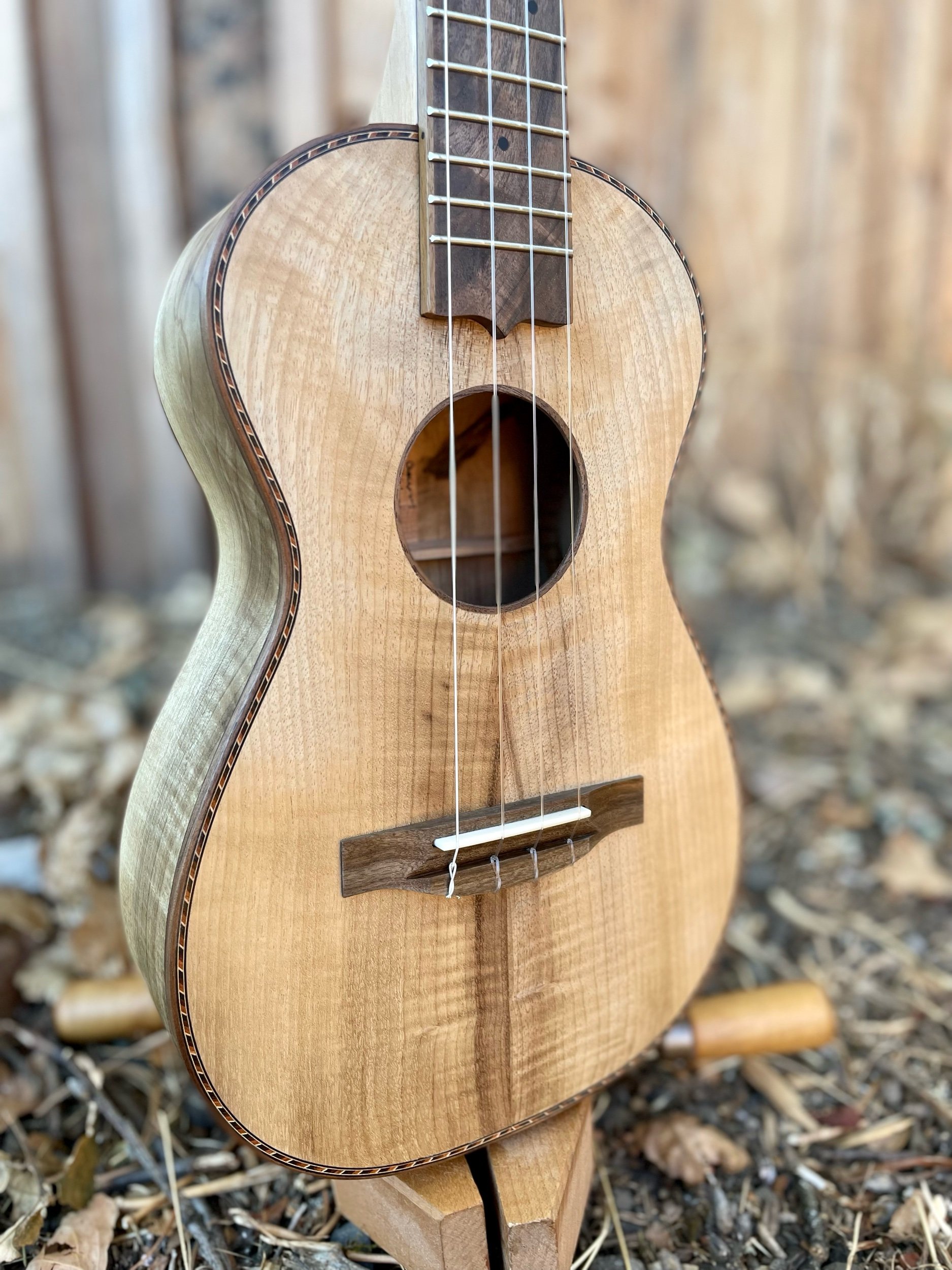This Myrtle tenor is a real stunner, with a Mastergrade set that is just crazy to look at. I paired it with some subtler Pistachio so that it wouldn’t get too fancy and some Myrtle binding to wrap it all up. The neck is a three piece lamination of maple and Cedar of Lebanon, which is the traditional Cedar tree from the Levant and is mentioned in the Bible. I thought the customer would appreciate it, as he is a pastor. The Myrtle is from the Oregon coast and the Pistachio from California Orchards via woodfromthewest.com. The Cedar is from shop at Camp Westwind, although I have no idea how Cedar of Lebanon got there!
#742- Fir and Koa Soprano Ukulele
Just a simple instrument, inspired by the materials and techniques of the first generation of ukuleles. Salvaged old growth Douglas Fir top, Koa back, sides and neck, walnut fretboard/head plate/bridge/binding. I’m trying for an elusive mix of old time sparkle with modern sustain.
“Hi Nicole and Aaron!
Uke arrived yesterday. It is gorgeous and puts out a purdy sound too.:) Seriously, I Love It! Also to date, I have never touched an instrument with a neck as smooth as this one. It feels amazing. And if I were a better player maybe it would allow me to become the Eddie Van Halen of Ukes.
Without intending to, I became more of a uke collector, not much of a player. Many of the ukes are vintage or handcrafted, really special in some specific way. Aaron’s ukes offer me both, wonderful to play and beautiful to collect. Learning about the wood selected and background of the build is special. The Beansprout site describes Beansprouts as folk art. And they truly are. They are folk art that makes me want to hold it, touch it, and just listen to it sing. It offers joy. Each one I am lucky enough to have, makes its very own unique music. Thank you Aaron and Nicole for doing what you do and sharing this gift.
Take care!
D. M. ”
#757- Curly Cherry and Wine Barrel Oak Four String Banjo
This one was very fun for me. We knew the customer wanted Curly Cherry as the main wood, but we weren’t sure on the secondary wood. I was on a walk up the road when I thought of all the Oak barrel staves I had from our neighbors at Hiyu Wine Farm. As I got into the project, I realized we could use some of the Oak that was still stained from the wine! Once it was dressed up like that, the rest of the details followed easily. 11” Cherry block rim with Oak cap. 20” scale length Cherry neck with Oak stripes and Oak fretboard/head plate as well. The Goat skin is stained with Walnut shells from our yard. Arm rest and pickup complete the package.
#749- Spruce and Curly Walnut Alto Ukulele
This alto is for a repeat customer who needs a low g uke that is easy to play and has great tone all the way up the neck. She wanted some of our Oregon Spruce from Camp Westwind for the top and I added a Yellow Cedar neck from Camp Westwind to match. The curly Walnut back and sides are a real beauty, from the shorts bin at Goby in Portland. We used some reddish pistachio from California orchards for the rest and some maple binding and bird’s foot purfling to tie it together.
#743- Cedar and Mahogany Scout Ukulele
Here is October’s Scout ukulele, made from shop scraps in my extra time. Cedar top salvaged from a hot tub, Mahogany back and sides, Fir neck and Walnut everything else. I used a little reddish oil stain and two coats of oil and wax. It’s rustic, honest and really fun to play.
#747- Port Orford Cedar and Walnut Tenor Ukulele
When a customer isn’t sure what to pick, I steer them to this combo: Port Orford Cedar top and Walnut back and sides. It’s local, easy to work, looks great and sounds very balanced. This ukulele is no exception to the rule and the pickup and low g make it extra useful.
The POC top is from the Oregon coast and the Pistachio is from California orchards, both via woodfromthewest.com. The Walnut is from the scrap bin at Goby in Portland. The POC neck is from my neighbors shop, who is a retired flute maker.
#740- Mastergrade Myrtle Baritone Ukulele
This baritone ukulele was designed by Nicole! She picked out all the wood and gave feedback along the way when I had decisions to make. It was a fun process and as you can tell, she likes fancy looking ukes! Mastergrade Myrtle body from the Oregon coast, Pistachio fretboard from California orchards, both from woodfromthewest.com. The neck is some salvaged Fir with a maple stripe. The binding, head plate and bridge are made from figured maple, with a Pistachio star in the headstock. Bird’s foot purfling adds some bling and a K&K pickup is built in, ready for the stage! Geared tuners, bone nut and saddle, our custom strings and a big voice!
“I wanted you to know that I received the ukulele in great condition.
I have been playing it every day for the last five days and I love it. I currently own nine ukuleles, so this one makes ten. It has quickly become my favorite. It is beautiful in both sound and appearance.
Nicole, you did a wonderful job in your selections of the woods and input on the design. Aaron, your craftsmanship and artistry is amazing. I know I will be playing this one for years.
Thanks again for the wonderful instrument!
-H.L. ”
#741- Mastergrade Myrtle Baritone Ukulele
I’ve made a habit of selling my personal instruments after playing them for a year or two. After all, I don’t want to upset the sales gods by saying no, and I can always make myself a new one. In this case, I needed a simple baritone ukulele, fast. I chose some beautiful Myrtle I got from Epilogue Lumber. It’s urban salvage and very beautiful. I paired it with some salvaged Douglas Fir and Walnut scraps from a tree here in Hood River.
#738- Spruce and Maple Scout Ukulele
Another scrap bin special here at Beansprout! Maple from my kitchen cabinet project, Spruce from a guitar leftover, Cedar from an old hotub and some Cherry from the Carpenter Ant stash. It’s bright and cheerful, with a nice percussive sound. It’s off to the Scout waiting list asap.
#734-Koa Tenor Ukulele
Koa. It’s a classic. I don’t buy new Koa, but when I stumble upon it or can salvage it, I always do. This Koa is Clockmaker’s Koa from the Carpenter Ant Stash in Portland. It was originally imported by Lizann’s grandfather to make clocks. The Fir neck is salvaged from a floor joist and the Walnut is from a friend’s tree in Hood River. It is light, easy to play, loud and sweet! I’ll be making a donation to plant new Koa trees in Hawaii, so can you right here.
“Greetings from sunny South Carolina! Special thanks to Aaron, Nicole, and Henry for all of the many years of developing and harvesting Beanspout! I feel very fortunate to be part of the Beansprout family now. The Koa uke is, yes, simple; but the warmth, brightness, and melodic voice is simply heavenly. I am so grateful and blessed by you all. All the best! Peace and love,
- K. C. ”
#732- Walnut and Pistachio Five String Banjo
It would be easy to think that this banjo, with a 12” inch walnut rim, no tone ring and non steel strings would be too dark/quiet/warm. But nope, still sounds like a banjo! It’s just the ultimate in sustain, warmth and richness but still has the brightness and punch to do its banjo jobs. The Walnut is a local tree to me, milled by Chris at The Dee Mill. The grafted Pistachio is from California Orchards.
“Good morning Nicole and Aaron,
Even though you sent pics and videos along the way as you were crafting my new banjo, I was still overwhelmed by just how truly gorgeous it is in person. I’ve played guitar for years, but I’m pretty new to the banjo... fortunately, this Beansprout is very forgiving and patient with me as I play, and her sound is the perfect warmth and earthiness I was looking for. I couldn’t be happier. I keep her right here next to me in the home office and pick her up often when the “work walls” start closing in on me.
Thank you so much for putting your heart into building and presenting me with this new Beansprout. I promise to uphold my end of the bargain. She will be right here next to me for years, and I’ll do my very best to fill the air with great music.
I’m so happy I found Beansprout. I’m already saving up for a uke! All the best to you and the family, and wishing you all a wonderful upcoming holiday season.
Cheers,
- M. P. ”
#736- Western Red Cedar and Dogwood Tenor Ukulele
This instrument is inspired by a baritone ukulele I made for Lizann, keeper of the Carpenter Ant stash. I like how all the reds, tans and browns flow together with no black purfling, laminations or inlays. The Dogwood back and sides are from a tree on Lizann’s property that her dad Ken milled many years ago. Dogwood is rather hard and serves well as a back and sides for ukuleles. The Cedar top is also from the Carpenter Ant stash, from a board that Ken bought to use for ukuleles. The Pistachio fretboard/head plate/bridge is all green/brown swirls, which is a good match to the Dogwood. The Cedar of Lebanon neck is from the scrap bin at Camp Westwind. I have no idea if it was labeled correctly or how this non-native tree came to be there. Cedar is a nice choice for ukuleles, as it has nice sustain and a rusty brightness as well.
#733- Curly Myrtle Soprano Ukulele
We have always called Myrtle “Oregon Koa” and this one lives up to the title. It looks nice, sounds nice, is local to us and easy to work. In a soprano like this, it sounds like the more traditional Koa, but with a little more sparkle. This Myrtle comes from the Carpenter Ant stash in Portland, the Walnut from Hood River and the Fir is salvaged from a floor joist.
#731- Walnut and Pistachio Five String Banjo
The combination of a Walnut rim, a skin head and non steel strings is always fun. It is dark and rich, but has plenty of growl and punch when I dig in. I like that the customer added some rope binding and a brass arm rest to make it a little fancier. If I were left to my own devices, I would probably make all the banjos a little too plain! The Walnut is from Hood River via The Dee Mill and the Pistachio is from California orchards.
“Aaron and Nicole,
I just wanted to let you know that my 5-string banjo arrived yesterday and was in perfect condition. As with the other Beansprout instruments, I couldn’t be more pleased with how this instrument has turned out.
As I have said before, I appreciate your philosophy of primarily using local and salvaged wood in your instruments. The care and thought you give to each of your instruments shows in all the details and high quality of your craftsmanship.
Most importantly I am very pleased by the sound of this instrument. I was looking for an “organic” and darker sound spectrum in my banjo as compared to the bluegrass banjo that I have been using. It is a much better sounding instrument for accompanying my voice and playing solo and in small groups.
I feel very fortunate and honored to have Beansprout instruments and look forward to continuing to make music with them. Thank you also, Nicole, for your part and artistry in supporting the Beansprout experience.
Aaron, Nicole, and Henry....take care, stay safe and stay well.
- D. B. ”
#735- Western Red Cedar and Curly Walnut Alto Ukulele
Man, this one is pretty! I really love the sapwood in the Cedar top, the wavy Pistachio head plate and the bird’s foot purfling. This combo is always sweet sounding, with a rich sustain but chiming sparkle too. The Cedar is from luthier Jayson Bowerman near Bend, OR. The Walnut is from Goby in Portland. The Pistachio is from California orchards and the Cypress neck is salvaged from an old tank.
#729- Western Red Cedar and Walnut Alto Ukulele
This ukulele is for our friend Melany, who has run the Tunes in the Dunes event at Camp Westwind for the last 10 years. I wanted to make an instrument rooted in the beautiful place she lives, right on the Salmon River, across from Westwind.
The top, headate, endgraft and healcap are all Western Red Cedar from a fence post salvaged from her property. The top was planed and sanded while the rest retains the rough texture, moss and lichen from the post. The walnut back, sides and fretboard are from Hood River, from a standing dead tree likely planted over 100 years ago. I love all the swirling colors of it. I used Alder for the neck, as it is another Oregon wood vital to the forests and waterways. The binding is greenish Myrtle from the coast, tying it all together in a muted way. For the strap buttons, I used rusty fence staples from her post, I love their rough texture compared to the smooth wood.
If you peek in the sound hole, you will see a little collection of moss, shells and sand from Westwind. To help protect the vital Salmon River watersheds, go here to learn more and donate.
#737- Alaskan Yellow Cedar and White Oak Tenor Ukulele
This AYC top came from neighbor’s shop, left over from when he made flutes. It inspired me to make an all domestic wood instrument with the muted color palette I like. The White Oak is from the Carpenter Ant stash and the AYC neck is from Camp Westwind. A mix of Myrtle and Walnut was used for binding and bridge, which complements the amber tones but fits in the palette. And the sound! I always love Oak for back and sides, but this piece of AYC warms it up a bit.
#726- Curly Port Orford Cedar and Mahogany Alto Ukulele
This beautiful stock instrument went to music camp with me and did not come home. It is made entirely of salvaged wood. The Port Orford Cedar top comes from cleaning out my flute making neighbors shop, the Jatoba fretboard/head plate/bridge comes from the Carpenter Ant Stash, the African Mahogany comes from an estate sale in Colorado and the Spanish cedar neck is from a retired banjo builder.
#722- Curly Myrtle Tenor Ukulele
This is a stock tenor I made to take to two music camps this month. If it makes it through those without finiding a home, it will be available on our website. Myrtle tenor ukes have been our bread and butter all the way back to the Mya-Moe days. Bright but rich, beautiful and local, Myrtle is always a classic choice. This Myrtle is from the Carpenter Ant stash, the Walnut is from a Hood River walnut tree and the the Fir is salvaged from a floor joist.
#727- Western Red Cedar and Curly Walnut Baritone Ukulele
This instrument is our second for musician/actress Zooey Deschanel. She wanted a baritone uke that looked fancy and had a deep rich sound. No problem. I drew some inspiration from the singing cowboys of Hollywood’s golden age for the inlay and rope binding. Looks fancy to me! The top is salvaged Western Red Cedar from wall boards. The Claro Walnut back and sides and the Spanish Cedar neck are from retired luthiers. The Pistachio is from California Orchards.



